Question (5 marks)
Question a (2 mark)
Use the data and diagram to identify each of the materials the ray passes through.
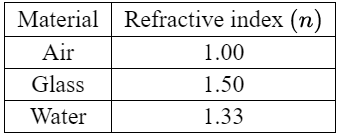
Fill the label to the correct layer.
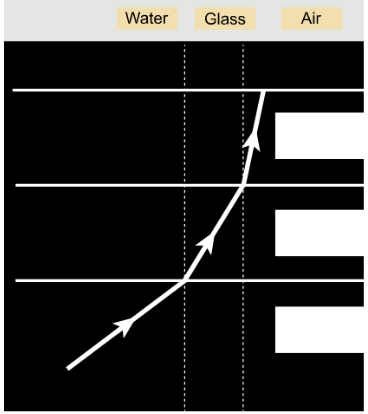
▶️Answer/Explanation
Ans:
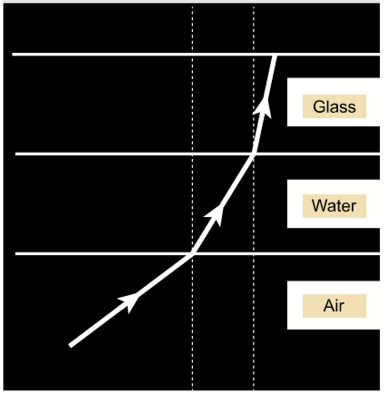
Question b (3 mark)
Explain your answer to part (a).
▶️Answer/Explanation
Ans:
When light passes from one medium to another, such as from air to water or from air to glass, it undergoes refraction. Refraction occurs because light travels at different speeds in different mediums.
If a ray of light passes from a medium with a lower refractive index to a medium with a higher refractive index, such as from air to water, the ray bends toward the normal line, perpendicular to the surface of the medium. This bending of the light ray toward the normal is known as “towards normal” refraction.
The phenomenon of refraction and the direction of bending depend on the relative refractive indices of the two mediums involved. The angle at which the light ray bends depends on the incident angle and the refractive indices of the mediums.
It’s important to note that the bending of light towards the normal occurs when light travels from a medium with a lower refractive index to a medium with a higher refractive index. If the situation is reversed, and light travels from a medium with a higher refractive index to a medium with a lower refractive index, the light ray would bend away from the normal, known as “away from normal” refraction.
So we can see ray is bending towards normal after each refraction , means they are going in to higher refractive index. $\rm{Air<water<glass}$
Developing a hypothesis
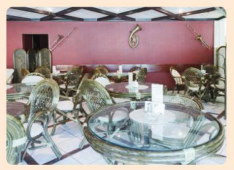
The owners of a café want more customers. They think that changing the café’s name will gain more customers.
Question:
Is this a good hypothesis?
▶️Answer/Explanation
Ans: No, it does not state the expected relationship between the café’s name and the number of customers. It is not very precise over the nature of the change. It is equally possible that changing
the name could attract fewer customers!
Question:
How could the hypothesis be improved?
▶️Answer/Explanation
Ans: Specify how the name will be changed.
Question:
How could the hypothesis be tested?
▶️Answer/Explanation
Ans: For example:
- Record the number of customers for number of days with current name.
- Change name and record number of customers for same amount of time.
- Compare average number of customers each day to determine if the name change has had an effect.
Noise cancellation
Destructive interference can be used to reduce background noise. Noise cancelation can be used to reduce the volume of sound from the engine in a car or airplane cockpit. Noise-canceling headphones detect ambient sounds outside the headphones and produce an opposite wave inside the headphones, which destructively interferes and reduces the amount of outside noise that is heard.
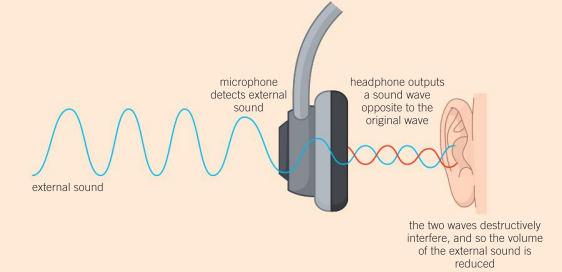
Question:
Suggest one benefit and one disadvantage of noise-canceling headphones.
▶️Answer/Explanation
Ans: Benefits
- Good sound quality
- Suitable for use in loud environments
Disadvantages
- Expensive
- User unable to hear surroundings, which could be dangerous for them (for example, walking near traffic)
Question:
Other than in headphones, suggest one use of noise-canceling technology.
▶️Answer/Explanation
Ans:
- Loud machinery; for example, the inside of a car or plane can have the engine noise cancelled
- Sound proofing in rooms
Question:
The reflection of sound is often heard as an echo. If a person claps her hands and hears an echo off a wall 0.25s later, how far away is the wall? The speed of sound is 330ms–1.
▶️Answer/Explanation
Ans: \(330\times 0.25=82.5 m;\frac{82.5}{2}=41.3 m\)
Question:
Light can be reflected off the Moon. The Apollo astronauts put some reflectors on the Moon which enable a laser beam to be reflected back to Earth. The moon is 384,400km away and light travels at 3 × 108ms–1. How long does it take the light to travel from the Earth to the Moon and back?
▶️Answer/Explanation
Ans: \(\frac{384400\times 10^{3}}{3\times 10^{8}}=1.28s; 1.28\times 2=2.56 s\)
Question:
At a certain time of day, the Sun is 20° above the horizon. The Sun’s light hits the surface of a calm lake and is reflected.
a) What is the angle of incidence?
▶️Answer/Explanation
Ans: 70°
b) What is the angle of reflection?
▶️Answer/Explanation
Ans: 70°
Question:
If the sound waves speed up, will they bend toward the normal or away from it?
▶️Answer/Explanation
Ans: Away from the normal.
Question:
On a copy of the diagram, continue the lines showing the direction of the sound waves.
▶️Answer/Explanation
Ans: When sound enters warmer air, it bends away from the normal. It then bends towards the normal again.
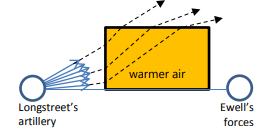
Question:
The refractive index of glass is 1.5.
a) Calculate the speed of light in the glass.
▶️Answer/Explanation
Ans: \(n=\frac{1}{sin(\theta _{c})^{‘}};sin(\theta _{c})=0.67;\)
θc = sin–1(0.67) = 41.8°
b) If light is incident on the glass at 45° from the air (n = 1), calculate the angle of refraction in the glass.
▶️Answer/Explanation
Ans: \(sin(\theta _{r})=\frac{sin(45)}{1.5}=\frac{\sqrt{2}}{3};\theta _{r}=28.1^{0}\)
Question:
Light passes from the glass into water which has a refractive index of 1.33.
a) Does the light speed up or slow down?
▶️Answer/Explanation
Ans: Speed up.
b) Would you expect the light to refract towards or away from the normal?
▶️Answer/Explanation
Ans: Away from the normal.
Question:
Glass has a refractive index of 1.5. Calculate the critical angle for this material.
▶️Answer/Explanation
Ans: \(sin(\theta _{c})=\frac{1}{1.5};\theta _{c}=41.8^{0}\)
Question:
What would the refractive index of a material have to be in order to have a critical angle of 30°?
▶️Answer/Explanation
Ans: \(\frac{1}{sin(30)}=2\)
Question:
Why doesn’t total internal reflection occur when light travels from air into water?
▶️Answer/Explanation
Ans: The refractive index of water is greater than the refractive index of air. Using Snell’s law, sin(θc) = 1.33, so there is no value for θc.
Question:
Sound waves speed up when they enter water. In air, the speed of sound is about 330ms–1, but in water the sound waves travel at about 1,500ms–1. Explain whether total internal reflection will occur when sound travels from air into water or from water into air. Explain how this affects how well you can hear sounds above the surface of the water if you are under the surface (it may help to calculate the refractive index and the critical angle).
▶️Answer/Explanation
Ans: Total internal reflection occurs when waves speed up. Therefore total internal reflection can occur when sound from the air hits the surface of water.
The ratio between speeds is \(\frac{1500}{330}=4.54\) so the equivalent refractive index is 4.54.
Therefore the critical angle = 12.7°
This is a small critical angle. Most sound will be totally internally reflected back into the air. Therefore it is hard to hear sounds above the surface of the water when you are underwater.
Question:
A tennis player can serve a tennis ball at 45ms–1. The tennis ball has a mass of 0.06kg. Using the equation \(\lambda =\frac{h}{mv}\) where h = 6.626 × 10–36Js, calculate the wavelength of the tennis ball. How does the tennis ball’s wavelength compare to the size of the tennis ball?
▶️Answer/Explanation
Ans: \(\frac{6.626\times 10^{-36}}{0.06\times 45}=2.45\times 10^{-36}m\)
The wavelength is a lot smaller than the diameter of the tennis ball. [Editor’s note: Planck’s constant is given incorrectly in the first edition of MYP Physics – actual value is 6.626×10–34 J s]
Summative assessment
Optical fibers
Question:
Light enters an optical fiber at an angle of incidence of 15°.
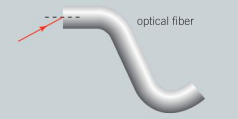
a) On a copy of this drawing, draw a line to show how the path of the light continues down the fiber.
▶️Answer/Explanation
Ans: Award marks for: normal line drawn; two reflections drawn; with angle of incidence = angle of reflection.
b) The refractive index of the fiber is 1.4. Calculate the angle of refraction of the light beam shown entering the fiber.
▶️Answer/Explanation
Ans: \(sin(\theta _{r})=\frac{sin(15)}{1.4},=0.185;\theta _{r}=10.7^{0}\)
c) Calculate the critical angle for this optical fiber.
▶️Answer/Explanation
Ans: \(sin(\theta _{c})=\frac{1}{1.4},=0.715;\theta _{c}=45.6^{0}\)
d) Calculate the speed of the light in the fiber.
▶️Answer/Explanation
Ans: \(\frac{3\times 10^{8}}{1.4};=2.14\times 10^{8}ms^{-1}\)
e) Some of the light is reflected off the surface instead of being refracted and entering the fiber. The amount of reflected light can be found from the equation:
\(R=\left ( \frac{n-1}{n+1} \right )^{2}\)
where R is the fraction of light that is reflected and n is the refractive index of the material. Using this equation, show that most of the light is refracted into the fiber.
▶️Answer/Explanation
Ans: \(R=\left ( \frac{1.4-1}{1.4+1} \right )^{2};=0.028\)
2.8% of light is reflected; and the majority is refracted.
Investigating the refractive index of water
When designing an optical fiber, scientists need to consider the effects of temperature on the refractive index. As an initial experiment, they measure the refractive index of water at different temperatures.
Question:
Suggest what the independent and dependent variables for their experiment should be.
▶️Answer/Explanation
Ans: Independent variable – temperature
Dependent variable – refractive index of water
The scientists use a laser pen and a rectangular tank of water. They take a photograph of the tank from above:
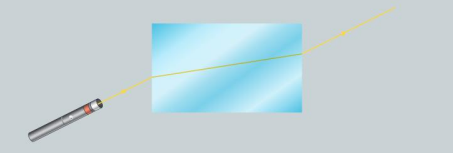
Question:
Give the names of two pieces of measuring equipment that the scientists will need.
▶️Answer/Explanation
Ans:
- Protractor;
- Thermometer.
Question:
Outline how the refractive index may be found from this picture.
▶️Answer/Explanation
Ans: Draw normal at right angles to boundary; Measure the angle of incidence and angle of refraction with the protractor; Use Snell’s law to calculate the refractive index.
Question:
Outline the method they should follow to obtain suitable data.
▶️Answer/Explanation
Ans: Measure the temperature of the water and record this value; measure and record the angle of incidence and angle of refraction of the laser beam going into the water tank; repeat at this temperature; change temperature (for example, using a kettle/water bath); repeat for a range of temperatures; at least 5 different temperatures.
The scientists think that as the water is heated up, it will expand slightly and therefore be less dense. As a result, they think that the hotter water will not slow the light down by the same amount, and so light will be able to travel through hotter water at a slightly faster speed.
Question:
Write a hypothesis for this experiment based on these ideas.
▶️Answer/Explanation
Ans: Sensible hypothesis; correctly linking variables; with explanation. For example:
As the temperature of the water increases; the refractive index of the water will increase; this is because the density of the water decreases at higher temperatures; causing light to travel faster through the water; \(n=\frac{1}{c}\)
Measuring the speed of light through an optical fiber
An experiment was conducted to determine the speed of light through a fiber optic cable. An electrical signal was sent to an LED. The light from the LED was transmitted down the optical fiber and a pulse was detected at the other end. An oscilloscope was used to measure the time delay between the initial electrical pulse and the detected signal. A diagram of the apparatus is shown below.
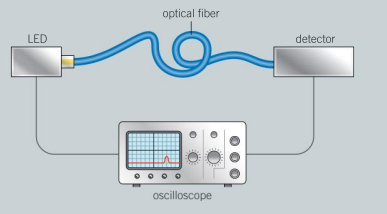
When the length of optical fiber is 80 m, the signal on the oscilloscope appears like this.
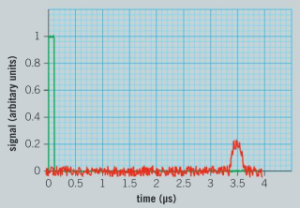
Question:
Measure the time delay between the initial signal and the detected signal.
▶️Answer/Explanation
Ans: 3.52 – 0.1; = 3.42 s
The length of the optical fiber is varied and the delay between the signals is measured. A graph of the results is shown below.
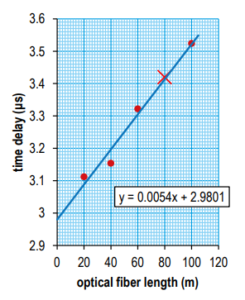
Question:
On a copy of the graph, add the result from when the optical fiber was 80 m long.
▶️Answer/Explanation
Ans: Point correctly plotted.
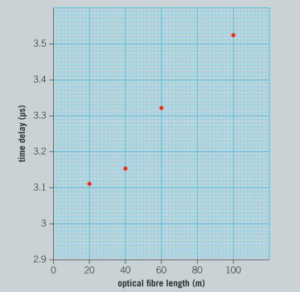
Question:
Add a line of best fit to your copy of the graph.
▶️Answer/Explanation
Ans: Straight line of best fit
Question:
Find the gradient of your line of best fit.
▶️Answer/Explanation
Ans: 0.0054 µs m–1 (accept ±0.002)
Question:
Using your value for the gradient, calculate the speed of the light through the fiber giving your answer in m s−1.
▶️Answer/Explanation
Ans: Light takes 0.054 µs to travel 1 m; 0.054 µs =5.4 × 10–8 s;
\(speed = \frac{d}{t}=\frac{1}{5.4\times 10^{-8}}; = 1.85 \times 10^{7}ms^{-1}\)
Question:
Explain why you would expect your answer above to be less than 300,000 km s−1.
▶️Answer/Explanation
Ans: 300,000 km s-1 = 3 × 108 m s-1 = speed of light in vacuum; nothing can travel faster than speed of light in vacuum.
Question:
Even without the optical fiber, there was a delay between the initial electrical signal being sent and the detection of a signal from the detector. Use your graph to find this time delay.
▶️Answer/Explanation
Ans: Find y-intercept; = 2.98 µs
Uses of optical fibers
Imagine that you work for a company that manufactures optical fibers. You need to convince the local government to spend money on replacing their existing telecommunications wire cables with optical fibers.
Question:
Write a brief for the local authority outlining how optical fibers work and how they can be used to transmit information. You should use simple scientific terms in a way that is understandable to non-scientists.
▶️Answer/Explanation
Ans: Award marks for correct use of scientific language that concisely explains how the optical fiber can transmit information.
Question:
Describe the advantages and disadvantages of optical fibers over traditional wire cables for transmitting information.
▶️Answer/Explanation
Ans: Award one mark for each advantage/disadvantage and one for each description or comparison to conventional cables. Examples:
Advantages
- Lots of information can be transmitted
- Less susceptible to interference than copper cables
- Less power loss than in copper cables
- Very secure
- Light and small diameter
Disadvantages
- Fragile
- Difficult to install
- Expensive
Question:
Rural communities sometimes have slow internet speeds available to them. Telecommunications companies often say that it is too expensive to provide faster optical fiber links. Outline a
counterargument to this.
▶️Answer/Explanation
Ans: Award marks for a well-argued paragraph.
